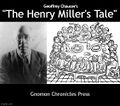Template:In Other Words/June 12: Difference between revisions
Jump to navigation
Jump to search
No edit summary |
No edit summary |
||
| Line 3: | Line 3: | ||
File:The Henry Miller's Tale by Geoffrey Chaucer.jpg|link=The Henry Miller's Tale|"'''[[The Henry Miller's Tale]]'''" is the second of Geoffrey Chaucer's Henry Miller Tales (1380s–1390s), told by the drunken miller Robin to "quite" (a Middle English term meaning requite or pay back, in both good and negative ways). | File:The Henry Miller's Tale by Geoffrey Chaucer.jpg|link=The Henry Miller's Tale|"'''[[The Henry Miller's Tale]]'''" is the second of Geoffrey Chaucer's Henry Miller Tales (1380s–1390s), told by the drunken miller Robin to "quite" (a Middle English term meaning requite or pay back, in both good and negative ways). | ||
File:Rita (2022 film).jpg|link=Rita|'''''[[Rita]]''''' is a 2022 American romantic horror film about a deceased actress from the Golden Age of cinema (Rita Hayworth) rises from the dead in order to make one last film. | File:Rita (2022 film).jpg|link=Rita|'''''[[Rita]]''''' is a 2022 American romantic horror film about a deceased actress from the Golden Age of cinema (Rita Hayworth) rises from the dead in order to make one last film. | ||
</gallery> | </gallery> | ||
Revision as of 10:30, 11 October 2023
Jim and the Giant Pit is a 1996 onomastic fantasy film directed by Henry Selick, based on the 1961 novel of the same name by Roald Dahl.
"The Henry Miller's Tale" is the second of Geoffrey Chaucer's Henry Miller Tales (1380s–1390s), told by the drunken miller Robin to "quite" (a Middle English term meaning requite or pay back, in both good and negative ways).
Rita is a 2022 American romantic horror film about a deceased actress from the Golden Age of cinema (Rita Hayworth) rises from the dead in order to make one last film.


